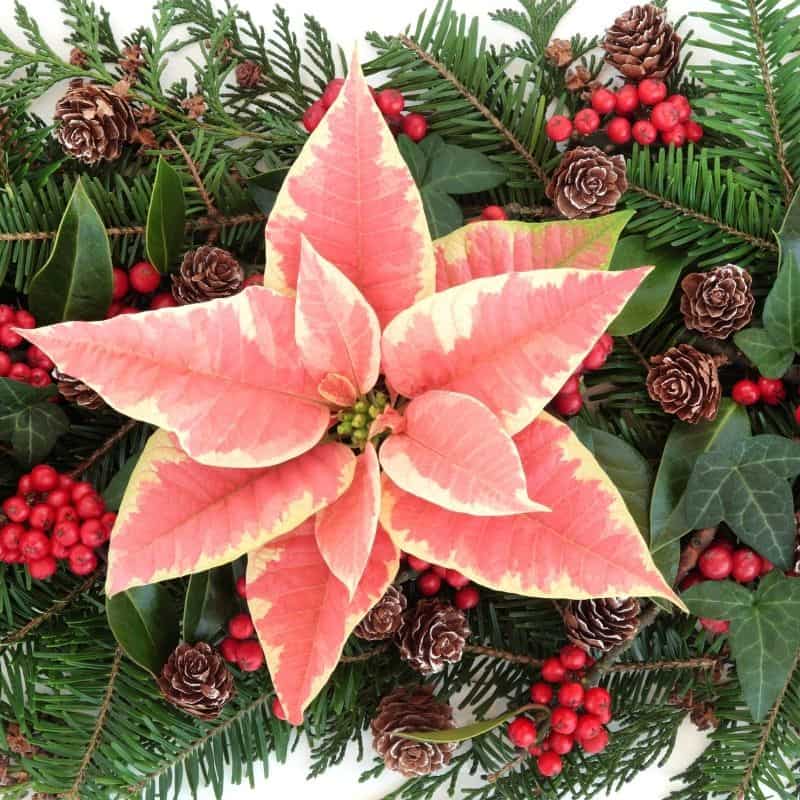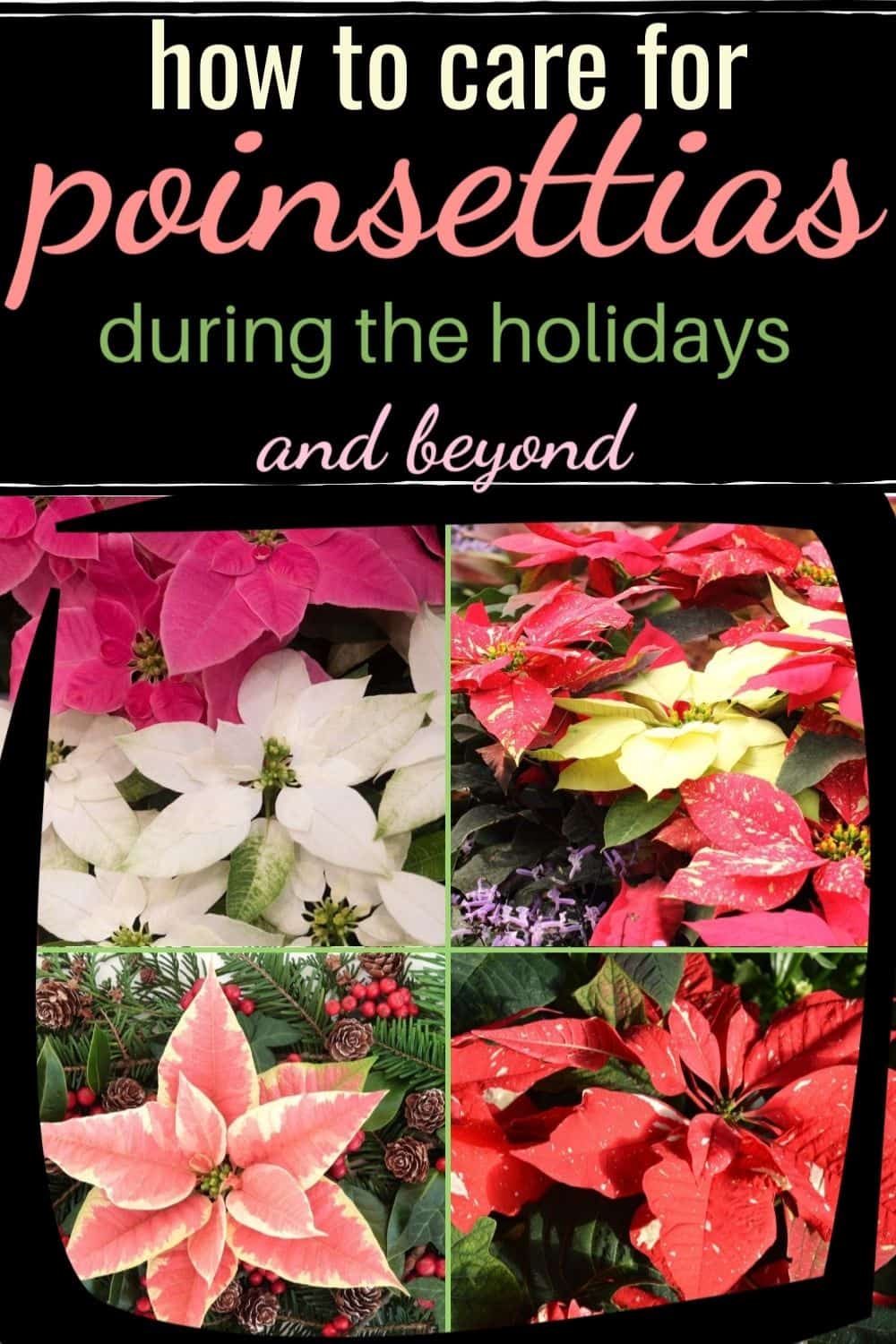One of the most popular Christmas plants, poinsettias (Euphorbia pulcherrima) is actually a woody perennial shrub native to Mexico and Central America. In their native habitat, these seemingly delicate houseplants actually reach heights of 10 to 15 feet. So how do you keep a tiny version of this shrub alive in your house throughout the holiday season? Keep reading for tips on how to care for poinsettias during the holidays and beyond.

How to Care for Poinsettias
Many of the poinsettias available around Christmastime are hybrid versions of the original tropical shrub, selected to be shorter and stockier and to retain their showy bracts longer. They have been adapted to average household conditions and are relatively easy to care for when you know how to do so properly.
Choosing a poinsettia plant
First, if you don’t already have a poinsettia, it’s helpful to begin by choosing the right plant. There are more than a hundred varieties of poinsettias available, including classic red ones as well as purple Plum Pudding, yellow Lemon Drop, spotted Jingle Bells, and even self-explanatory Tri-Color.
The size also ranges from one to three feet. While the variety depends on your personal preference, the important part is to choose a healthy plant.
Look for full, compact plants with dark green leaves from just under the colorful bracts to almost the base of the stem and unopened green or yellow buds. Additionally, there should be no signs of damage from disease, pests, or breakage.

Poinsettia plant care instructions
During the holiday blooming period, place the poinsettia in a location that receives at least six hours of bright, indirect sunlight each day. Avoid direct sunlight, which might discolor the bracts.
Poinsettias thrive in average home conditions — 60 to 70 F is ideal — but keep them away from drafts and sources of abrupt temperature changes, like heaters and woodstoves.
While the decorative wrapper may be left on if you like, do remove it for watering, as poinsettias don’t like wet feet. When the soil surface feels dry, place the poinsettia in the sink and water thoroughly, then allow any excess moisture to drain out before returning the pot to its wrapper or saucer.
Once the bracts begin to fade, you can choose to dump the poinsettia in the compost pile or take steps to encourage it to rebloom next year — it is a perennial, after all!
How to care for poinsettias year-round
With proper care, poinsettia plants can live beyond Christmas to bloom again next year.
- Remove the plant from its decorative wrapper after the holidays and place it on a saucer to improve drainage and reduce the likelihood of root rot. Once the bracts begin to fade, you can apply an all-purpose houseplant fertilizer every two to four weeks, according to package instructions.
- When the plant gets leggy, usually by April, cut it back to about six inches and repot in a slightly larger container with fresh potting soil.
- In the late spring or early summer, when overnight temperatures stay above 50 F, you can move the plant outside to a location that receives partial shade, then gradually introduce it to full sun.
- Pinch off growing tips in late summer to encourage branching.
- Bring the poinsettia back inside when the weather cools again before it dips below 50 F. As with Christmas cacti, long nights signal to poinsettias that it’s time to bloom again.
- Around the first of October, ensure that the poinsettia receives 13 hours of darkness each night by placing it in a closet or covering it with a box, returning it to its indirect sunlight during the day.
- Stop the dark treatments around Thanksgiving and reduce watering and fertilizer applications.
- The poinsettia should put on colorful bracts by Christmas and rebloom.
- Stop fertilizing altogether during the blooming period.
Poinsettia pictures
While the most popular poinsettias are the traditional red color, there are many other colors and combinations of color available these days. Here are just a few.

I love this arrangement for the holidays: a bit of evergreen, some cones and berries, and a beautiful pink and yellow poinsettia as the focal point. Beautiful!

These days, many different colors of poinsettias are available with added color. They are not everyone’s favorites, but some might like them to match their festive decor.

Have you seen yellow poinsettias? WOW! they are gorgeous! Here’s a yellow poinsettia surrounded by a unique yellow streaked red poinsettia. So pretty!
Poinsettia problems and FAQs
If you follow the poinsettia care tips outlined above, you should have a happy, healthy poinsettia plant. However, sometimes problems do occur. Here are a few common problems and how to correct them.
Why are my poinsettia leaves falling off?
Poinsettia leaves wilting, turning yellow, and falling off are actually common symptoms of several different problems, all related to plant stress. Is your poinsettia located near a drafty door, window, or heater? Drafts and rapid changes in temperature can cause stress, so move your poinsettia to a more stable location if you suspect this might be the root of your problem.
Over- and underwatering can also result in wilting or dropped leaves. Wait until the soil feels dry, then soak until water drains out the bottom of the pot (first remove from decorative wrapper, if applicable). Leave the plant in a sink until it stops draining, then return it to its saucer or wrapper. It may help to check the soil every day or two until you figure out a regular watering schedule.
If a poinsettia is consistently overwatered, it may succumb to root rot and need to be replaced.
Are poinsettias poisonous to pets and humans?
Despite their bad reputation, poinsettias are only mildly toxic to humans and animals. The milky sap can cause skin irritation, especially for those with a latex allergy, and consuming significant amounts of the plant can cause vomiting and diarrhea. While they’re not particularly dangerous, it’s probably best to keep poinsettias out of reach of exceptionally curious pets and children.
Deck the halls … with pots of poinsettias
It seems odd that tropical plants should become staples of a holiday that so often conjures images of snow, but poinsettias look undeniably festive with their vibrant red bracts and green leaves. And with the right care, you can enjoy that color from the same plant next year, too!





Beautiful Flower Garden Ideas
Thursday 25th of February 2021
[…] How to Care for Poinsettias During the Holidays and Beyond […]
Norfolk Island Pine - Care Tips For The Christmas Tree Houseplant
Thursday 17th of December 2020
[…] more Christmas plants? You’ll love a poinsettia or two around the living room, and a Christmas cactus is a great addition to your houseplant […]